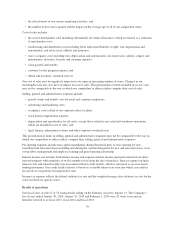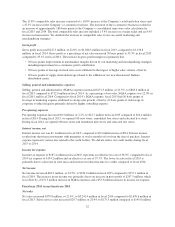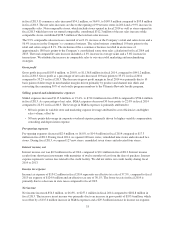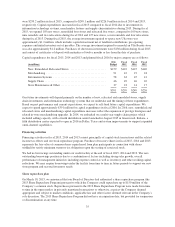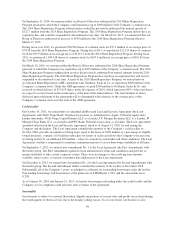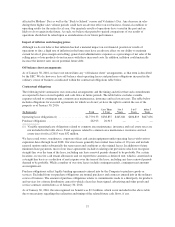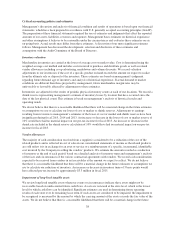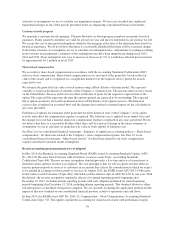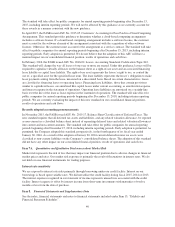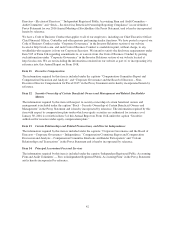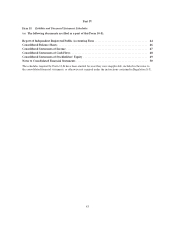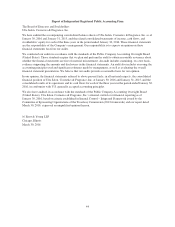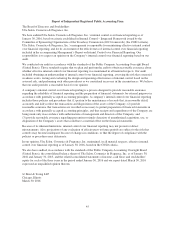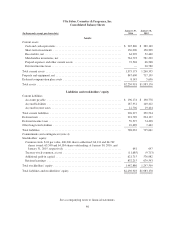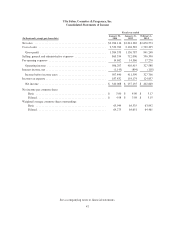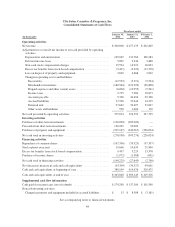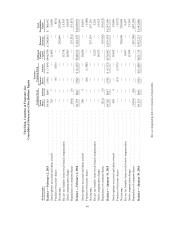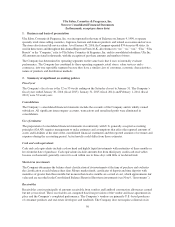Ulta 2015 Annual Report Download - page 46
Download and view the complete annual report
Please find page 46 of the 2015 Ulta annual report below. You can navigate through the pages in the report by either clicking on the pages listed below, or by using the keyword search tool below to find specific information within the annual report.The standard will take effect for public companies for annual reporting periods beginning after December 15,
2015, including interim reporting periods. We will not be affected by this guidance as we currently account for
these awards in a manner consistent with the new guidance.
In April 2015, the FASB issued ASU No. 2015-05, Customers’ Accounting for Fees Paid in a Cloud Computing
Arrangement. This standard provides guidance to determine whether a cloud-based computing arrangement
includes a software license. If a cloud-based computing arrangement includes a software license, the customer
must account for the software element of the arrangement consistent with the acquisition of other software
licenses. Otherwise, the customer must account for the arrangement as a service contract. The standard will take
effect for public companies for annual reporting periods beginning after December 15, 2015, including interim
reporting periods. Early adoption is permitted. We do not believe that the adoption of this ASU will have a
material impact on our consolidated financial position, results of operations and cash flows.
In February 2016, the FASB issued ASU No. 2016-02, Leases, Accounting Standards Codification Topic 842.
This standard will change the way all leases of one year or more are treated. Under this guidance, lessees will be
required to capitalize virtually all leases on the balance sheet as a right-of-use asset and an associated financing
lease liability or capital lease liability. The right-of-use asset represents the lessee’s right to use, or control the
use of, a specified asset for the specified lease term. The lease liability represents the lessee’s obligation to make
lease payments arising from the lease, measured on a discounted basis. Based on certain characteristics, leases
are classified as financing leases or operating leases. Financing lease liabilities, those that contain provisions
similar to capitalized leases, are amortized like capital leases under current accounting, as amortization expense
and interest expense in the statement of operations. Operating lease liabilities are amortized on a straight-line
basis over the life of the lease as lease expense in the statement of operations. The standard will take effect for
public companies for annual reporting periods beginning after December 15, 2018, including interim reporting
periods. We are currently evaluating the impact of this new standard on our consolidated financial position,
results of operations and cash flows.
Recently adopted accounting pronouncements
In November 2015, the FASB issued ASU No. 2015-17, Balance Sheet Classification of Deferred Taxes. The
new standard requires that all deferred tax assets and liabilities, and any related valuation allowance, be reported
as non-current in a classified balance sheet instead of separating deferred taxes and related valuation allowances
into current and non-current amounts. The standard will take effect for public companies for annual reporting
periods beginning after December 15, 2016, including interim reporting periods. Early adoption is permitted. As
permitted, the Company adopted this standard, prospectively, in the fourth quarter of its fiscal year ended
January 30, 2016. As a result of the adoption at January 30, 2016 current deferred income tax assets were
classified as non-current liabilities on the Company’s consolidated balance sheets. The adoption of this standard
did not have any other impact on our consolidated financial position, results of operations and cash flows.
Item 7A. Quantitative and Qualitative Disclosures about Market Risk
Market risk represents the risk of loss that may impact our financial position due to adverse changes in financial
market prices and rates. Our market risk exposure is primarily the result of fluctuations in interest rates. We do
not hold or issue financial instruments for trading purposes.
Interest rate sensitivity
We are exposed to interest rate risks primarily through borrowing under our credit facility. Interest on our
borrowings is based upon variable rates. We did not utilize the credit facility during fiscal 2015, 2014 or 2013.
The interest expense recognized in our statement of income represents unused fees associated with the credit
facility. Interest expense is offset by interest income from short-term investments with maturities of twelve
months or less from the date of purchase.
Item 8. Financial Statements and Supplementary Data
See the index, financial statements and notes to financial statements included under Item 15, “Exhibits and
Financial Statement Schedules”.
40


